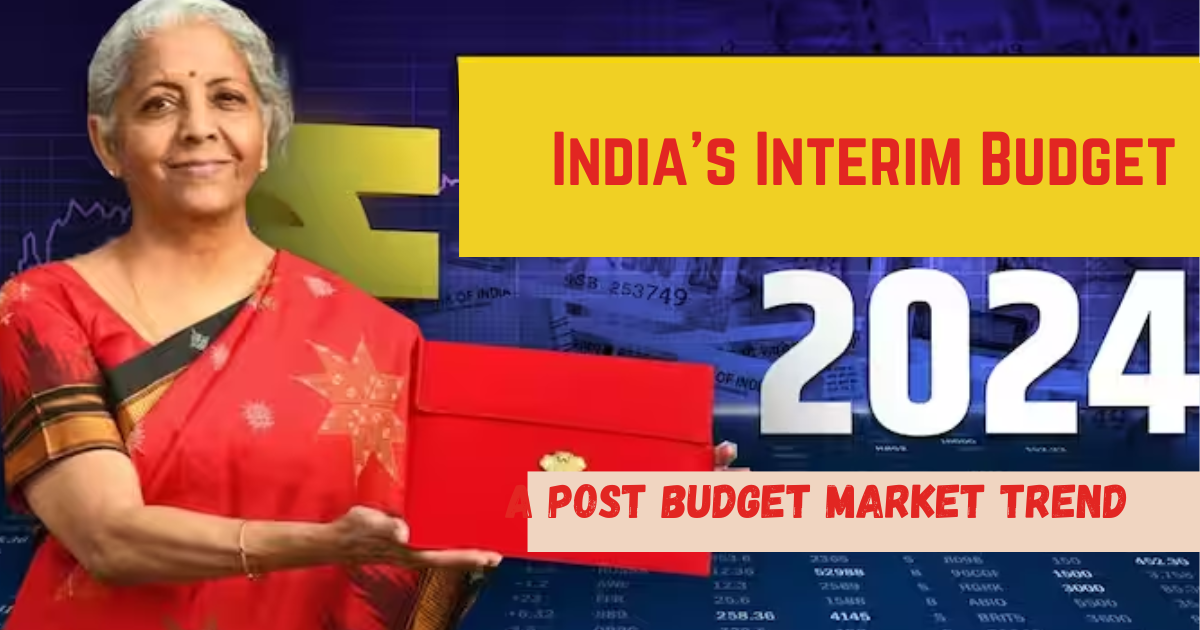Budget 2024: Post-Budget Market Trends

As the dust settles on Budget 2024, investors find themselves at a pivotal moment, the important part is yet to see that is market’s response and craft a strategy that helps to connect with the evolving economic growth. The Indian market, following the interim budget presentation, experienced fluctuations, reflecting the intricate interplay between fiscal policies, investor sentiment, and global economic cues.
Market Recap:
On February 1st, after the government announced the interim budget 2024, the Indian stock market didn’t do as well as expected. Before the budget announcement, people were feeling hopeful, and the stock market was doing really well, with the main stock indices going up a lot. But after the budget details were revealed, the stock market didn’t stay up; instead, it went down a bit. Both the BSE Sensex and Nifty, which are important measures of the market, ended up lower, though not by much. This shows that investors were unsure about how the budget would affect things, and they were trying to figure out what it all meant for the economy and their investments.
Budget Highlights:
The interim budget highlight fiscal consolidation, with a focus on key sectors such as infrastructure, agriculture, green growth, and railways. Notably, there were no changes in tax rates, which is disappointing for some segments of the population. However, the government’s commitment to fiscal prudence was evident, with targets set for Fiscal Deficit and capex, signaling a prioritization of strong capital expenditure.
Expert Perspectives:
Various experts weighed in on the market’s performance and provided insights into potential strategies post-budget:
- Sonam Srivastava emphasized a strategic, long-term approach, advocating diversification into sectors aligned with government policy initiatives.
- Ajit Mishra highlighted the market’s narrow range trading post-budget, advising a cautious, stock-specific trading approach amidst mixed sectoral trends.
- Siddhartha Khemka identified potential beneficiaries of the budget, citing sectors such as affordable housing, infrastructure, and consumption, while anticipating positive market momentum.
- Raj Vyas hailed the budget’s fiscal rectitude and projected positive impacts on banking stocks, emphasizing the reduction in fiscal deficit and borrowing.
Navigating Forward:
Considering what experts have said, investors should be careful and think carefully about how they invest their money. It’s important to balance short-term moves with long-term plans. The budget focuses on specific areas where there could be opportunities for investors who invest in the same things the government is focusing on. But it’s also important to be cautious and not get too excited because the global economy and how companies are doing financially are still uncertain. So, it’s like being hopeful but also being careful and thinking ahead.
Market Strategy:
- Diversification: Spread investments across sectors poised for growth, leveraging government initiatives in infrastructure, green technologies, and agriculture.
- Quality over Quantity: Prioritize quality stocks over excessive exposure, particularly amidst market volatility and uncertain global cues.
- Long-Term Vision: Maintain a strategic, long-term perspective, considering the enduring impact of fiscal policies on sectoral growth trajectories.
- Stay Informed: Remain abreast of market developments, economic indicators, and global trends to make informed investment decisions.
- Adaptability: Stay flexible and adaptable to changing market conditions, adjusting strategies as warranted by evolving economic dynamics.
In conclusion, while the interim budget may have sparked short-term market fluctuations, it also unveils opportunities for astute investors attuned to emerging sectoral trends and government priorities. By navigating post-budget market trends with vigilance, prudence, and a strategic outlook, investors can position themselves for success amidst the ever-evolving financial landscape.